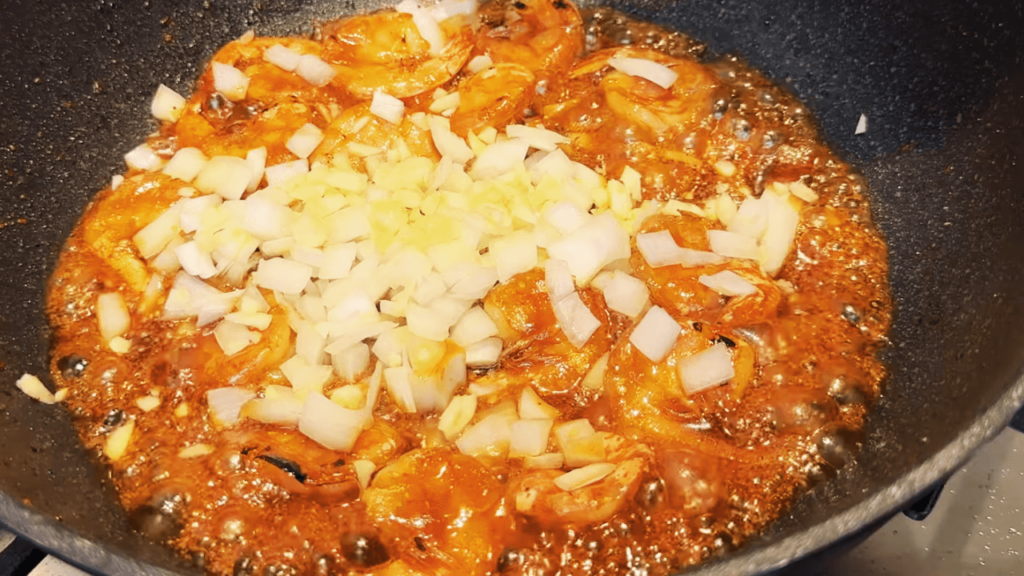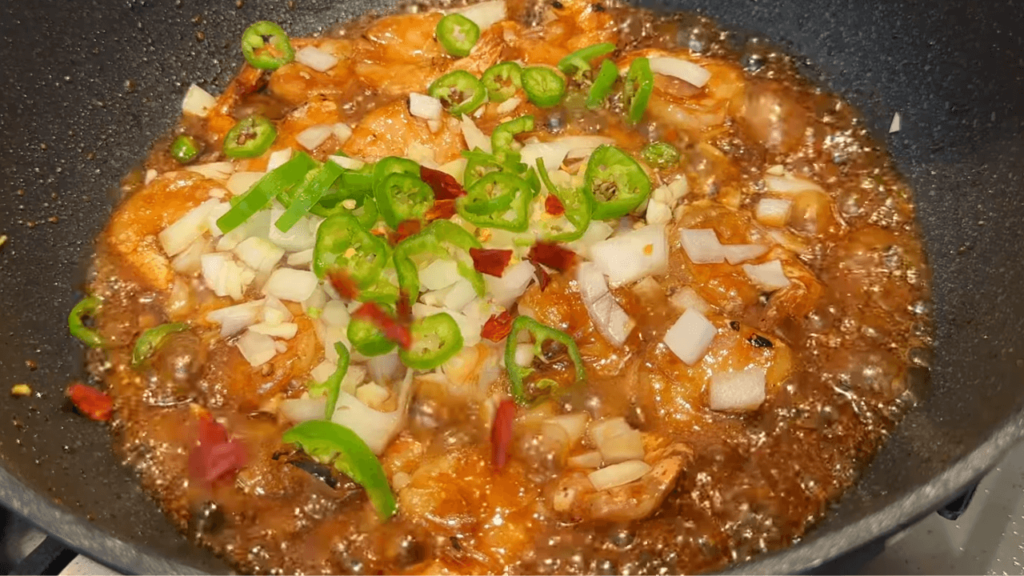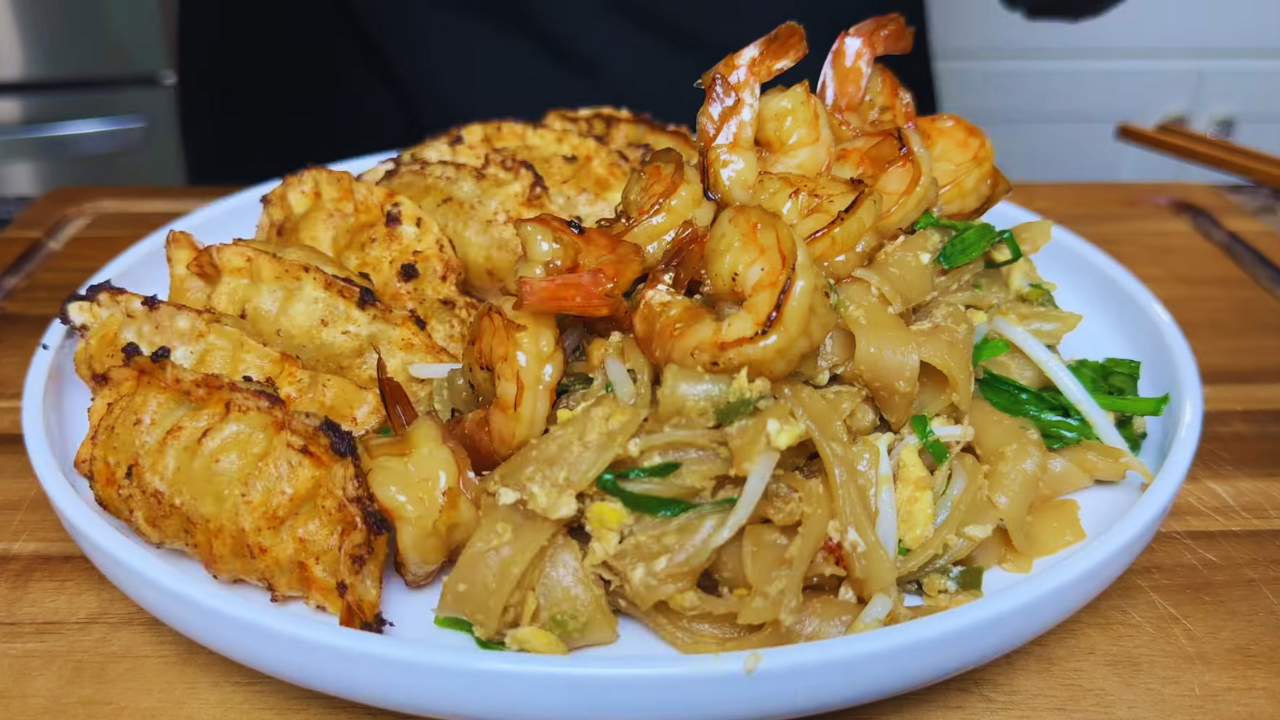Introduction to Cry Baby Noodles recipe
Origin and Popularity
Cry Baby Noodles recipe isn’t just a dish; it’s a cultural phenomenon, inspired by the Netflix series ‘Hunger’. This dish has captivated food enthusiasts worldwide, thanks to its unique blend of flavors and textures. It’s a symphony of spicy, savory, and umami notes, each playing a crucial role in its taste profile.
The dish’s name, intriguing and whimsical, reflects its bold and intense flavors that are meant to tantalize and tease the taste buds. Originating from Asian cuisine, it incorporates ingredients like lap cheong (Chinese sausage), dried shrimp, and fish cake tofu, creating a rich tapestry of tastes and textures.
The popularity of Cry Baby Noodles recipe soared as viewers of ‘Hunger’ sought to experience the flavors they saw on screen. It’s a dish that tells a story, a culinary journey that goes beyond the usual noodle fare. Its fame is a testament to the power of media in influencing food trends and bringing global cuisines to our dinner tables.
In the next section, we’ll dive into the essential ingredients that make up this tantalizing dish, including suggestions for substitutions to cater to various dietary needs. Stay tuned as we unravel the secrets of making perfect Cry Baby Noodles.
Ingredients for the Cry Baby Noodles Recipe
Essential Ingredients for Cry Baby Noodles
To embark on this culinary adventure, you’ll need a specific set of ingredients that are the soul of Cry Baby Noodles. The dish’s heart lies in its combination of lap cheong (Chinese sausage), dried shrimp, and fish cake tofu. These ingredients bring a unique blend of textures and flavors – the lap cheong adds a sweet, smoky taste, while the dried shrimp contributes a crispy, salty bite, and the fish cake tofu introduces a soft, spongy texture.
Alongside these, you’ll need rice noodles, which form the base of the dish. They are perfect for soaking up the rich flavors of the sauces and seasonings. Speaking of which, the sauces are crucial: a mix of XO sauce, miso paste, soy sauce, and oyster sauce creates a complex, layered flavor profile. This combination ensures a burst of umami with every bite.
Garlic, ginger, and scallions are also essential, adding freshness and a slight kick to the dish. And let’s not forget the eggs, which bring everything together with their creamy texture.
Substitutes for Common Allergens
Now, let’s talk about substitutions, because everyone deserves to enjoy Cry Baby Noodles, regardless of dietary restrictions. If you’re allergic to shellfish, you can replace the dried shrimp with chopped nuts for a similar crunch. For those who don’t consume pork, chicken sausage can be a great substitute for lap cheong.
Vegetarians can also join in on this culinary journey. Replace the meat and seafood with a variety of vegetables like bell peppers, mushrooms, and tofu. These not only add color but also bring their own unique flavors and textures to the dish.
In the next section, we’ll dive into the step-by-step cooking guide, ensuring you can recreate this masterpiece in your own kitchen. Get ready to stir, fry, and savor!
Step-by-Step Cooking Guide
Preparing the Ingredients for Cry Baby Noodles Recipe
Before you start cooking, it’s crucial to have all your ingredients prepped and ready.
This is not just a cooking tip, but a golden rule in the world of Cry Baby Noodles. Dice the lap cheong and fish cake tofu into bite-sized pieces. Mince the garlic and ginger finely, and chop the scallions. Having everything prepared in advance makes the cooking process smooth and enjoyable.
Cooking Techniques and Tips

Now, let’s dive into the heart of cooking Cry Baby Noodles. Begin by heating a bit of oil in a wok over medium heat. Add the dried shrimp and fry until they turn golden and crispy. This not only cooks the shrimp but also infuses the oil with a rich, seafood flavor.
Next, cook the lap cheong. The key here is to let it crisp up slightly, releasing its smoky, sweet flavors into the oil. Then, add the minced garlic and ginger, sautéing them until they release their aroma. This is where the dish starts to come alive with fragrances.
Crack the eggs directly into the wok, quickly scrambling them with the other ingredients. The eggs act as a binder, bringing all the flavors together. Then, add the cooked rice noodles. Stir-fry them until they start to get a bit charred. This is where the magic happens – the noodles begin to absorb all the flavors in the wok.
Finally, season the dish. Combine XO sauce, miso paste, soy sauce, oyster sauce, MSG, and salt, and add them to the wok. Mix well to ensure the noodles are evenly coated with the sauces. Add the crispy dried shrimp and fish cake tofu back into the wok, toss in the chopped scallions, and give everything a good mix.

Serve the noodles immediately, garnishing with more scallions if desired. And there you have it, a plate of steaming, flavorful Cry Baby Noodles, ready to be devoured!
Flavor Profile and Texture
Balancing Spicy, Savory, and Umami
The allure of Cry Baby Noodles lies in its intricate balance of flavors. Each ingredient contributes to a symphony of tastes that dance on the palate. The lap cheong brings a sweet, smoky undertone, while the dried shrimp adds a hint of the sea with its salty, briny flavor. The fish cake tofu introduces a subtle, almost neutral taste, providing a canvas for the other flavors to shine.
The sauces are the real game-changers. XO sauce, with its seafood and chili pepper base, adds depth and a hint of spice. Miso paste contributes a savory, earthy umami that’s hard to replicate. Soy sauce brings its iconic saltiness, and oyster sauce rounds everything off with its sweet and savory notes. This combination creates a rich, multi-layered flavor profile that is distinctly Asian and incredibly satisfying.
Texture plays an equally important role in Cry Baby Noodles. The rice noodles, with their slightly chewy texture, are perfect for soaking up the rich sauce. The crispy dried shrimp and the slightly crunchy lap cheong add a delightful contrast, making each bite interesting. The soft, spongy fish cake tofu adds another layer of texture, ensuring that every mouthful is a new experience.
This dish is not just about taste; it’s about the experience. The blend of spicy, savory, and umami flavors, combined with the variety of textures, makes eating Cry Baby Noodles an adventure in itself.
Serving Suggestions for Your Cry Baby Noodles Dish
Best Side Dishes and Drinks
Once you’ve mastered the art of making Cry Baby Noodles, the next step is to turn it into a complete meal with the perfect accompaniments. The rich and robust flavors of the noodles pair wonderfully with lighter, refreshing side dishes. A simple salad, perhaps a mix of crisp greens with a light vinaigrette, can balance the intensity of the noodles.
For a more traditional approach, consider steamed or stir-fried vegetables. Broccoli, bok choy, or snow peas add a delightful crunch and a pop of color to your plate.
When it comes to beverages, you have a few delightful options. A cool, fizzy drink can cleanse the palate between bites of the spicy and savory noodles. If you’re in the mood for something alcoholic, a glass of white wine, particularly one with a hint of sweetness, complements the dish beautifully. It cuts through the richness and refreshes your taste buds.
For those who love to explore more Asian noodle recipes, pairing Cry Baby Noodles with other regional dishes can make for an exciting and varied meal. Think of adding a side of spring rolls or dumplings for a truly indulgent Asian feast.
Remember, the key to a great pairing is balance. You want to complement the flavors of the noodles without overpowering them. With these suggestions, you’re well on your way to creating a meal that’s not just delicious but also harmoniously balanced.
Variations of the Classic Cry Baby Noodles Recipe
The beauty of Cry Baby Noodles lies in its versatility. While the traditional recipe is a delight, there’s always room for creativity and adaptation to suit different tastes and dietary needs.
For a vegetarian twist, omit the lap cheong, dried shrimp, and fish cake tofu. Instead, load up on colorful vegetables like bell peppers, mushrooms, and snap peas. Tofu, either silken or firm depending on your texture preference, can be a great protein substitute. It absorbs the flavors of the sauces beautifully, making sure you don’t miss out on the dish’s signature umami taste.
If you’re looking to experiment with different meat options, consider using thinly sliced chicken or beef. These meats bring their own unique flavors and textures to the dish, creating a whole new experience. Seafood lovers can try adding prawns or squid for a different kind of sea flavor.
Another fun variation is to play with the spice levels. Add more chili oil or fresh chilies if you enjoy a fiery kick, or tone it down if you prefer a milder taste. The sauces can also be adjusted; for a sweeter profile, increase the oyster sauce, or for more saltiness, up the soy sauce.
These variations not only cater to different dietary preferences and palates but also add an element of personal touch to the dish. Experimenting with different ingredients and flavors can turn cooking Cry Baby Noodles into a fun and exciting culinary adventure.
Cooking Tips and Tricks
Expert Cooking Tips and Tricks
Creating the perfect Cry Baby Noodles is an art, and like any art, it comes with its own set of tips and tricks. Here are some expert suggestions to elevate your noodle game:
Prep is Key: As with any stir-fry dish, having all your ingredients prepped and ready to go is crucial. This ensures a smooth cooking process where you can add each ingredient at the right time without scrambling.
The Right Wok Heat: The secret to a great stir-fry is heat control. Your wok should be hot enough to cook quickly and give a slight char to the noodles, but not so hot that it burns the ingredients. This balance is key to achieving the perfect texture and flavor.
Sauce Savvy: When it comes to the sauces, balance is everything. Start with the recommended amounts, but don’t be afraid to adjust to your taste. Remember, you can always add more, but you can’t take it away.
Texture Tactics: For that perfect texture contrast, pay attention to how long you cook each ingredient. The dried shrimp should be crispy, the lap cheong slightly charred, and the vegetables (if using) should be tender but still crisp.
Noodle Know-How: Be mindful of the type of rice noodles you use. Some need to be soaked longer than others. Follow the package instructions to ensure they are the perfect texture before adding them to the wok.
Flavor Layering: Add your ingredients in stages. Start with the ones that take longest to cook and finish with those that need the least cooking time. This way, every ingredient is cooked perfectly, and the flavors are layered beautifully.
Taste and Adjust: Don’t forget to taste as you go. Adjust the seasoning to suit your palate. A little extra dash of soy sauce or a pinch of sugar can make all the difference.
By following these tips, you’ll not only enjoy the process of cooking Cry Baby Noodles but also ensure that the end result is as delicious as it can be.
FAQs
Frequently Asked Questions
Q: Can I make Cry Baby Noodles gluten-free?
A: Absolutely! To make Cry Baby Noodles gluten-free, use tamari sauce instead of regular soy sauce and ensure that your miso paste and XO sauce are gluten-free. Also, check that your rice noodles don’t contain any hidden gluten.
Q: What if I can’t find XO sauce?
A: XO sauce is unique, but you can substitute it with a combination of oyster sauce and a bit of chili oil or chili paste for heat. The flavor won’t be identical, but it will still be delicious.
Q: How can I make this dish vegan?
A: For a vegan version, omit the lap cheong, dried shrimp, and fish cake tofu. Use plant-based alternatives like tofu or tempeh, and ensure your sauces are vegan-friendly.
Q: Is it possible to prepare Cry Baby Noodles in advance?
A: While Cry Baby Noodles are best enjoyed fresh, you can prep all the ingredients ahead of time. Cook the noodles and store them separately, and then quickly stir-fry everything together when you’re ready to eat.
Q: How do I store leftovers?
A: Store any leftovers in an airtight container in the refrigerator for up to two days. Reheat in a wok or microwave, adding a little water or broth to moisten the noodles.
Conclusion:
For instance, “Now that you’ve mastered the Cry Baby Noodles Recipe, you’re ready to enjoy this delicious meal.”
To wrap it up, Cry Baby Noodles are more than just a tasty dish; they’re a fun cooking adventure. With their mix of spicy, savory, and umami flavors, and all the different textures, these noodles are a real treat. Whether you follow the classic recipe or try your own twist, you’re sure to have a great time making and eating them.
Cooking is about having fun and being creative, and Cry Baby Noodles are perfect for that. So, why wait? Get your ingredients, heat up your wok, and start cooking up some delicious noodles. Enjoy every bite.

